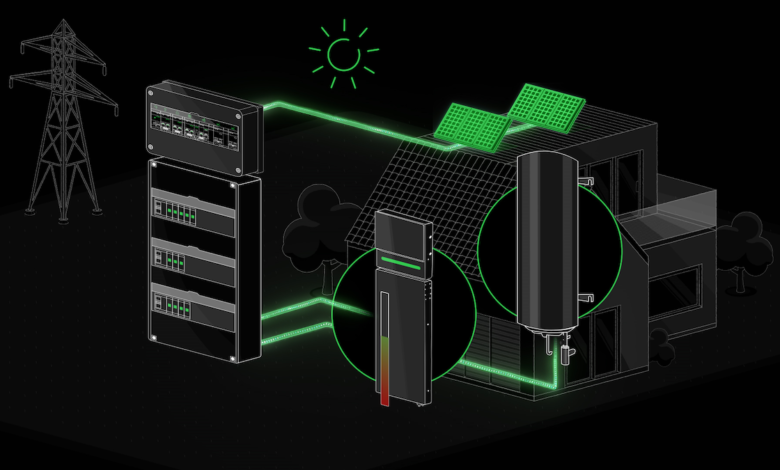Adapting Electrical Panels to Meet the Future’s More Demanding Loads

Post
Post
Share
Annotate
Save

The climate crisis is driving a global shift toward a new energy landscape, making safe and effective electrical distribution increasingly complex.
Year over year, the electrification of homes around the globe is increasing. Global electricity demand is projected to grow by an average of 3.4% annually from 2023 to 2026, according to the International Energy Agency. In 2023, 447 gigawatts of new solar photovoltaic (PV) cell capacity was deployed worldwide, and electric car sales surged by 25% in the first quarter of 2024 over the previous year.
The introduction of new technology into the home—electric vehicle (EV) chargers, solar panels, kitchen appliances, entertainment systems—presents homeowners with a challenge. Increased electrification can put outdated electrical panels at risk, heightening the need for safe and effective electrical distribution.
Mini Circuit Breakers
At the root of energy management and protection technology lies the miniature circuit breaker—a small yet transformative technology that celebrates its 100th anniversary in 2024.
Since early circuit breakers safeguarded the first electrified homes, they have developed and adapted to a world that is increasingly reliant on electricity. As demand for power grew, particularly in larger buildings and homes, so did the need for more organized and efficient electricity distribution.
The emergence of panel board technology allowed for the consolidation of multiple circuit breakers into a single enclosure. Additional protections against surges and device tripping came later, as electrical appliances became more widespread.
Today, new challenges are on the horizon. “While the electrical panel has adapted to meet new requirements for a century now, the new energy landscape presents a huge range of fresh challenges. For this reason, the electrical panel must also evolve from the solution we know today to meet these new demands,” says Michael Lotfy Gierges, executive vice president of home and distribution at Schneider Electric.
The Energy Revolution at Home
Electrical panels that are not designed to manage today’s more demanding loads can pose serious safety risks, including electrical fires and overloading due to increased electrification and drastically more energy pulled from the grid.
There is also a more complex range of power sources to manage. Homes are no longer solely powered by the grid. More homeowners are becoming “prosumers” who both produce and consume energy, embracing energy independence and making their homes more resilient to keep critical appliances powered during blackouts or outages from natural disasters.
Whereas most common electrical panels were configured only to have one source of power, homes today are powered in several ways, including renewables on the grid and micro-grids, solar panels, and battery backups. Technology that has worked for a century with relatively minor upgrades suddenly requires a revolution.
The Future of the Electrical Panel
Electricity is one of the cleanest energy sources available, and when produced from renewable resources, it is carbon neutral. However, there are risks and challenges associated with increased electrification. This includes aspects such as grid connectivity and the emergence of the prosumer model, where homes and buildings generate some or all of their own energy and may even sell excess energy back to the grid. It is essential that these processes are conducted safely and in compliance with regulations to protect both assets and human life.
“Innovation in this area is crucial to adapt to the evolving energy landscape and facilitate the energy transition,” Gierges says. “We are developing solutions that simplify the energy transition for homeowners and building operators, enabling them to navigate this shift safely.”
He says, “Additionally, we aim to support utilities in managing the unprecedented rise in demand driven by home electrification, electric vehicles, data centers, artificial intelligence, and other emerging technologies,” such as Schneider Electric’s new enhanced smart electrical panel solutions.
Fundamental electrical safety comes from securing sources of power for distribution. For homes both generating and storing power, it’s critical to have an updated panel that can switch between systems safely—and knows when to shut down certain appliances.
The latest generation of smart panels are equipped with circuit breakers configured to manage diverse energy sources and automate load shifting of larger loads, like EV chargers, with space to add sources and loads.
Reducing emissions is a core motivation for homeowners installing new energy landscape technology, and they need to feel empowered to manage their energy consumption. As the world moved into the digital age, the advent of smart technology led to the development of smart electrical panels capable of remote monitoring, energy consumption tracking, and even predictive maintenance.
These electrical panels integrate with home automation systems, allowing homeowners to control their electrical consumption in real time through apps. The degree of control smart panel technology offers is central to maximizing the energy-saving and resiliency capabilities of the new energy landscape.
The global shift toward a new energy landscape, driven by increasing electrification of homes and the integration of diverse energy sources, underscores the critical role of electrical panels in ensuring safe and efficient energy distribution. As homes become more reliant on technologies such as EV chargers, solar panels, and smart home devices, it’s an absolute must for homeowners to consider the safety of their electrical panels—making sure they are fit for the century to come.
Explore Schneider Electric innovations for safer and more energy-efficient homes.



